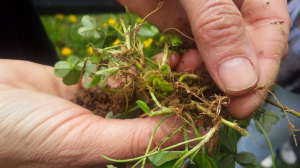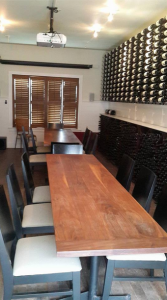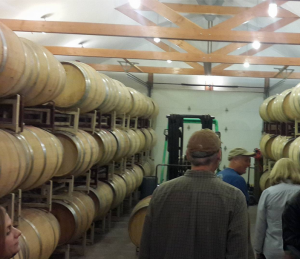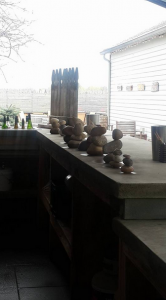Shinn Estate winery and vineyard were contributed by Barbara Shinn and her Husband David Page in a 20 acres land in Long Island in Spring 2000. Owner Barbara Shinn and her husband were immersed in the culture of Northern California art and cuisine. Later on, they decided to move to New York for vine growing and wine making
One of the owners, Barbara Shinn, was hosting the tour. She works as a vine grower on the Shinn Estate. Barbara was welcoming us with her enthusiasm and attentiveness by smiling at us and touching the grass in the vineyard in order to check if the grass was too wet for some of us to walk. During the tour, she explained to us about the methods that they used to feed their vines and protect their vines thoroughly.
Upon arrival to the vineyard, the first thing came to my eyes was not vines. Instead of these vines I saw a green colored sea of meadow and cover crops. Barbara explained that the green meadow and cover crops were the fertilizers that she planted for her grapes, and then she pulled out a clover and introduced it to us as one of the nitrogen makers in her vineyard. She explained that nitrogen works as fertilizer for grapes. There were more than 12 types of clovers planted underneath the vines in order to make just enough nitrogen for grapes by catching air from the leaves, transferring the air into nitrogen, and spreading out the nitrogen from their root to the soil.
Beside clover other things that Barbara applied to the vineyard were seaweed, fish liquid, and peanut shells. Peanut shells were also introduced as a nitrogen making agent. Fish liquid and seaweed were used to feed the micro bacteria and soil worms. What Barbara really wanted was the dead bodies of bacteria and soil worms because after they died and decayed, these dead bodies became nutrients for the vines. Based on what she explained to us about her vineyard, I literally connected the process of growing vine with the process of growing fetal. Vines’ grow in Barbara’s vineyard are more like babies grow in their mothers’ wombs while vines from many other vineyards that did not have meadows and cover crops are more like babies that grew in test tube.
There were eight grape varieties growing in this 20 acre vineyard. Red grapes are merlot, cabernet sauvignon, malbec, cabernet franc and peti verdot; white grapes are sauvignon Blanc, Pinot Blanc, Semillon. Peti verdot is used for blending because of its unique dark inky red color and spicy on palate. The choice about what to grow in the vineyard is based on agriculture: climate and soil tells you what can grow. White grapes are sauvignon Blanc, Pinot Blanc, Semillon. The cool climate and lighter gravity, loamy soil are very similar to Loire Valley in Bordeaux so Barbara and her husband chose grapes that were from Bordeaux mostly.
“After a few years’ investments, the first harvest was at 2002” said David Page. He hosted the second tour witch started ride next to the press bladder machine. At this time we learned that during the harvest season the vine growers handpick the grapes, check their quality, and transfer them to the presser bladder. Their juice will be chilled for two to three days in a tank until all the sediment sink to the bottom. They will be transferred to s second tank for fermentation at 55 degree.
Yes, they to protect their grape from browning and discoloration by oxidation, they do use smallest amount of sulfite in the vineyard. David Page explained the issue of using sulfite for wines because there are numbers of people do not like to consume products that contain sulfite because this is chemical. However, what I found from winesandvines.com was that the usage of sulfite is only dangerous for sensitive people and asthmatics.
David Page brought us to their library and then their cellar (not located underground, but the temperature was around 58 degree in the cellar). Actually we just passed by their library because it’s connected with their cellar and we had to walk through the library to get into the cellar.
David Page liked the French barrels for wine aging because they are tighter than American barrels and so they are able to maintain the uniqueness of the wine.
We were told proudly by David Page about the cellar room’s temperature which was maintained to 58 degree for the wine. They have a lot of wine in their cellar: 75 to 100 barrel for each vintage, and each barrel produces 300 bottles of wine. For each vintages, they keep 50 to 100 bottles for themselves, not to drink, but for their wine industry friends to taste the wine together and compare the wines from different vintages.
They have outdoor tastings, and each of us got chance to taste four different wines. I believed that the servers were all trained to have enough knowledge for wine tasting services because they were able to explain the wine to us thoroughly. The servers’ service speed was very fast, that looked like they wanted us to hurry up. For an additional comment, I think their outdoor tasting area could be expanded to a larger size so that their tasting room area personnel would not have to rush when they served customers.
After all, I realized that Barbara Shinn and David Page were compliment to each other’s characters. Barbara was more outgoing while David was a little less outgoing. They cooperate with each other very well in their business and in their marriage. Both of them were very knowledgeable on their part of the work and they also knew each other’s work deeply, which means they communicate with each other very well. I think to be successful in this industry, understanding, cooperation, communication and patience are the most important elements. At this case, Mr. and Mrs. Page have all of them.
http://shinnestatevineyards.com/vineyard/vineyard-philosophy
http://www.winesandvines.com/template.cfm?section=features&content=82324












I like your blog about your experience at the vineyard it sounds like it was a lot of fun.
Libraries are a place of learning, and, yes, this library did not have books but you did learn a lot. Your analysis was thorough.